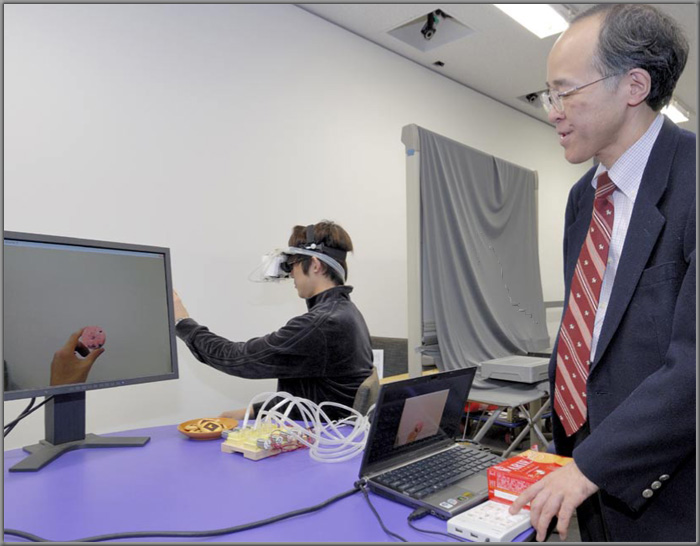Home > Highlighting JAPAN > Highlighting Japan JANUARY 2012 > Wired for Taste
Highlighting JAPAN
COVER STORY: Tomorrow's World
Caption: Professor Michitaka Hirose (right) stands before a monitor showing how a user perceives the cookie that he is holding.
Credit: YOSHIFUSA HASHIZUME
Wired for Taste
A team at the University of Tokyo led by Professor Michitaka Hirose is developing a device called MetaCookie+ that "changes" the taste of food being eaten. Toshio Matsubara reports.

The Metacookie+ head-mounted display is attached with numerous pipes that can deliver a range of smells to the user's nostrils.
Credit: YOSHIFUSA HASHIZUME
"The project originated with the idea of an undergraduate student of mine who wanted to change the taste of juice with each sip," says Professor Hirose, who heads the research. "We carried out an experiment in which we changed the color of a sour-sweet drink by illuminating it with a colorful LED light in a glass, and then studied how its taste changes. We found a sensory conflict between sight and taste, and many people perceived a change in the taste of the drink. I thought that if we added the olfactory sense to that, the effect would be further enhanced."
Here is roughly how the MetaCookie+ system works. First, the user puts on a head-mounted display (HMD) which has a pipe attached that emits smells. The user takes a cookie printed with a marker pattern and holds it in front of a camera built in to the HMD. Then, if the chocolate mode is chosen for example, a computer graphic (CG) image of a chocolate cookie is overlaid onto the cookie through the display. It is programmed so that when the face is brought closer to the cookie, the CG chocolate cookie too appears larger, so to the user it appears that he or she is holding a chocolate cookie. In addition, a scent is transmitted from the pipe at the end of the nose using a motor. This is set so that the intensity of the scent gets stronger as the cookie gets closer. In this way, a plain, unflavored cookie is perceived as having a chocolate flavor. The device offers the user a total of seven different smells and CG combinations, including cheese and lemon.
In tests, around 80 per cent of users of the MetaCookie+ said the taste of their food had changed. Tests have already been carried out in various locations, and when it was shown at the United States computer graphics exhibition SIGGRAPH 2010 (Special Interest Group on Computer Graphics), over 1,000 curious visitors lined up during the three-day event, with 80 percent saying that the taste of their food had changed.
However, this technology does not enable the user to perceive any taste at all. When tests were carried out on Japanese subjects using the smell of the matsutake mushroom, known in Japan for its good scent, the majority of people were not able to identify the taste even when looking at the CG image of a sliced matsutake overlaid on the cookie. This is because matsutake-flavored cookies do not actually exist. In other words, the sensory switch in respect of taste only engages when there is an image already imprinted on the brain, generating an illusion in respect of taste (participants in the tests were not told in advance what the taste was.)
"It is often said that the device could be used for hospital patients who have highly restricted diets, but that is only one example," says Professor Hirose. "The basis of this research has a profound link with psychology. It could be used in collaborative ventures with the Japanese Society for Medical Virtual Reality, which uses virtual reality in medical treatment, as well as, for example, to enhance the effectiveness of museum exhibits by introducing an olfactory stimulus. I believe that the potential application of this research is not limited to medical treatment alone, but extends to a variety of fields."
© 2009 Cabinet Office, Government of Japan






